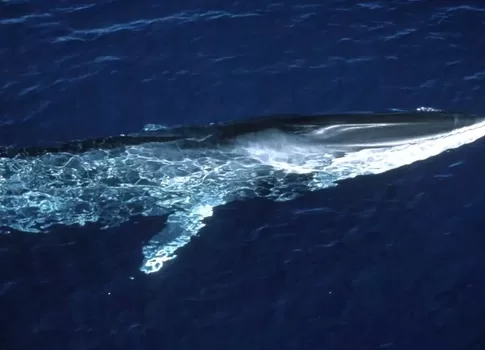In a move that has reignited international criticism, Japan has added fin whales to its commercial whaling quota. Fin whales, the second-largest whale species after blue whales, are listed as vulnerable to extinction on the International Union for Conservation of Nature (IUCN) Red List. Japan’s decision to include this species in its catch is controversial, sparking renewed debate over the ethics and sustainability of whaling in the 21st century.
“Australia is deeply disappointed by Japan’s decision to expand its commercial whaling program by adding fin whales,” said Australia’s Environment Minister, Tanya Plibersek.
“Australia is opposed to all commercial whaling and urges all countries to end this practice,” she said.
Our story on Japen’s fin whale hunt continues after this advertisement:
Japan’s Inclusion of Fin Whales in Its Quota
Japan’s decision to include fin whales in its commercial whaling quota marks a significant escalation in its whaling activities. Previously, Japan’s whaling program focused on minke, sei, and Bryde’s whales, which Japan argued were abundant enough to sustain limited hunting. The addition of fin whales, however, raises new concerns due to the species’ vulnerable status.
The Japanese government has set a quota that includes a small number of fin whales, arguing that the hunts are sustainable and carefully managed to avoid threatening the overall population. Japan’s Fisheries Agency maintains that the quotas are based on scientific assessments and are within sustainable limits. However, conservationists and environmental groups strongly disagree, warning that even a limited hunt could have severe consequences for fin whale populations, particularly in areas where they are still recovering.
International Reaction
The international response to Japan’s inclusion of fin whales in its whaling program has been overwhelmingly negative. Governments and environmental organizations have condemned the move, calling for Japan to reconsider its decision. Countries like Australia, New Zealand, and several European nations have issued statements expressing their disappointment and urging Japan to adhere to international conservation standards.
Environmental groups such as Greenpeace and the World Wildlife Fund (WWF) have also voiced their opposition, arguing that hunting fin whales is not only unnecessary but also ethically indefensible given the species’ vulnerable status. These organizations have called on the global community to apply pressure on Japan to halt its whaling activities and prioritize the protection of marine life.
Ethical and Environmental Considerations
The inclusion of fin whales in Japan’s commercial whaling program raises significant ethical and environmental questions. Fin whales are slow to reproduce, with a gestation period of 11 to 12 months and a long interval between births. This makes them particularly vulnerable to population declines due to hunting. Conservationists argue that even a small number of whales killed each year could have long-term impacts on the species’ recovery.
From an ethical standpoint, the hunting of fin whales is seen by many as a cruel and outdated practice. Whaling methods, which often involve the use of explosive harpoons, are considered inhumane by animal welfare advocates. Additionally, with the global decline in whale meat consumption and the availability of alternative protein sources, many question the necessity of continuing to hunt these endangered animals.
Background on Fin Whales
Fin whales are one of the most majestic creatures of the ocean, reaching lengths of up to 85 feet and weighing as much as 80 tons. Known for their speed and grace, they are sometimes referred to as the “greyhounds of the sea.” Despite their size and speed, fin whales have been heavily targeted by whalers, leading to a significant decline in their population during the 20th century.
Due to overhunting, fin whale populations plummeted, prompting international conservation efforts to protect the species. While there have been some signs of recovery, particularly in the North Atlantic, fin whales remain vulnerable, with an estimated global population of around 100,000 individuals.
The Future of Whaling in Japan
Japan’s decision to add fin whales to its commercial whaling quota represents a significant challenge for international conservation efforts. As the global community continues to grapple with the balance between cultural traditions and environmental stewardship, Japan’s whaling practices will likely remain a contentious issue.
The future of fin whales and other species targeted by Japan’s whaling industry is uncertain. While Japan maintains that its hunts are sustainable, the long-term impact on whale populations remains to be seen. The international community’s response to this latest development will be critical in shaping the future of whaling and the protection of vulnerable species like the fin whale.
In the coming years, the pressure on Japan to end its commercial whaling activities is likely to intensify. As more countries and organizations advocate for the protection of marine life, Japan may face increasing isolation on the world stage. Whether this will lead to a change in policy or a continuation of current practices will depend on the complex interplay of cultural, economic, and environmental factors.
The Controversial Resurgence of Japan’s Commercial Whaling
Japan’s return to commercial whaling has sparked international debate and drawn criticism from environmental groups, governments, and conservationists worldwide. While whaling has deep cultural roots in Japan, the modern practice is fraught with controversy, particularly concerning the sustainability of whale populations and the ethics of hunting these majestic creatures.
A Brief History of Whaling in Japan
Whaling has been a part of Japanese culture for centuries, with records dating back to the 12th century. Historically, it was a subsistence activity, with coastal communities relying on whale meat and other byproducts for their livelihoods. However, Japan’s whaling practices evolved over time, especially during the 20th century when large-scale commercial whaling became prominent.
Japan was a signatory to the International Whaling Commission (IWC) when it was established in 1946 to regulate whaling and conserve whale populations. In 1982, the IWC imposed a moratorium on commercial whaling due to declining whale populations. Japan, however, continued whaling under the guise of scientific research, exploiting a loophole in the IWC’s regulations that allowed for the killing of whales for research purposes.
This so-called “scientific whaling” was widely criticized, as the whale meat from these hunts was often sold commercially, undermining the spirit of the moratorium. Despite international pressure, Japan continued its whaling activities, arguing that it was a part of their cultural heritage and necessary for scientific study.
Japan’s Withdrawal from the IWC
In 2018, Japan made the controversial decision to withdraw from the IWC, effective from July 2019. This move allowed Japan to resume commercial whaling in its territorial waters and exclusive economic zone, but it also meant Japan could no longer hunt whales in the Southern Ocean, a practice it had engaged in under the guise of scientific research.
Japan’s government justified its withdrawal by stating that the IWC was failing to address the cultural significance of whaling for Japan and other whaling nations. The decision was met with global condemnation, particularly from countries that advocate for whale conservation and view whales as endangered species that should be protected, not hunted.
The Current State of Japan’s Commercial Whaling
Since resuming commercial whaling, Japan has set quotas for its whaling activities, allowing the hunting of minke, sei, and Bryde’s whales. The Japanese government argues that these species are abundant enough to support sustainable whaling practices. However, conservationists disagree, pointing to declining whale populations and the potential for long-term ecological damage.
Japan’s Fisheries Agency set an annual quota of 383 whales, which includes 171 minke whales, 187 Bryde’s whales, and 25 sei whales. While these numbers are lower than Japan’s previous catches under the scientific whaling program, they are still a cause for concern among environmental groups.
Economic and Cultural Factors
The revival of commercial whaling in Japan is not just about tradition; it’s also tied to economic interests. Whale meat is still a delicacy in some parts of Japan, although its consumption has significantly declined since the mid-20th century. The Japanese whaling industry employs a small but dedicated workforce, and some coastal communities rely on whaling as part of their cultural identity and local economy.
However, there is growing evidence that demand for whale meat in Japan is declining. According to reports, whale meat consumption has dropped significantly over the decades, and large quantities of whale meat remain unsold in storage. This decline in demand raises questions about the economic viability of Japan’s commercial whaling industry in the long term.
International Response and Ethical Considerations
Japan’s decision to resume commercial whaling has been met with strong opposition from the international community. Countries like Australia, New Zealand, and the United Kingdom have condemned the practice, calling for a ban on all forms of whaling. Environmental organizations like Greenpeace and the Sea Shepherd Conservation Society have been vocal in their criticism, arguing that whaling is inhumane and unnecessary in the 21st century.
The ethical debate surrounding whaling is complex. Supporters argue that it is a sustainable practice when properly regulated and that cultural traditions should be respected. Opponents, however, argue that whaling is cruel and outdated, with no place in a world where many whale species are still recovering from the brink of extinction.
The Future of Whaling in Japan
As Japan continues its commercial whaling activities, the international community will likely keep a close watch on the industry’s impact on whale populations and the marine environment. The debate over whaling is far from over, with strong arguments on both sides. However, with changing attitudes towards whale meat consumption within Japan and increasing global pressure, the future of Japan’s whaling industry remains uncertain.
In the end, Japan’s return to commercial whaling highlights the ongoing tension between cultural traditions and modern conservation efforts. Whether Japan will continue down this path or eventually phase out whaling altogether is a question that will likely be debated for years to come.

148 fin whales were slaughtered in 2022 in Iceland. Reports from the International Fund for Animal Welfare (IFAW) indicate that approximately a quarter of these whales were not killed on the first attempt, as the grenades attached to the harpoons failed to detonate inside them, highlighting the brutal nature of the hunt.
Related stories
Discovering the Secret Lives of Blue Whales in Timor-Leste
Scuba Diving on the Woodburn wreck, Suva, Fiji
Illawarra Offshore Wind Zone Declaration
John Butler should thank Big Oil & Gas for plastic
Nikonos III 35mm underwater film camera
Advertisement:




